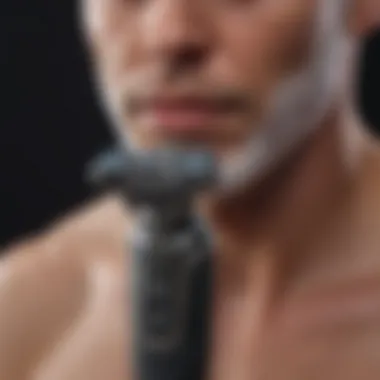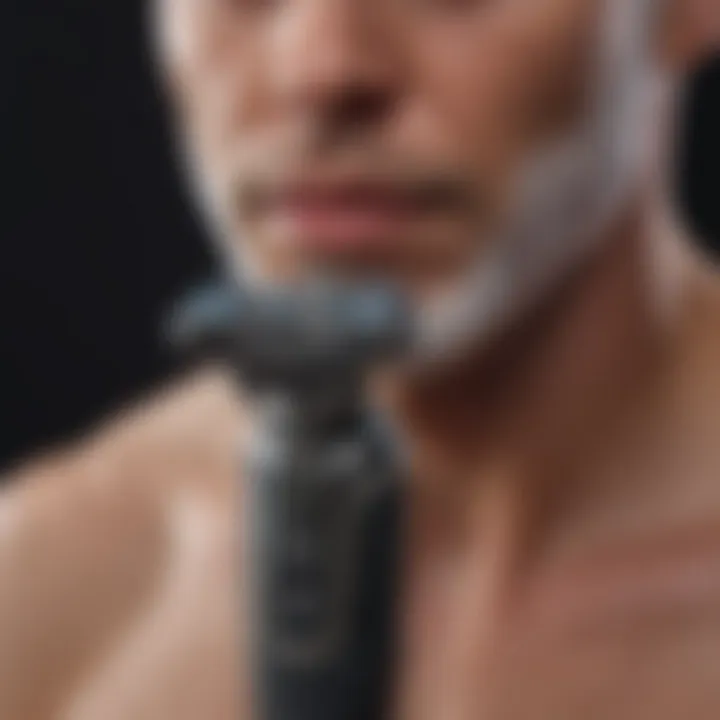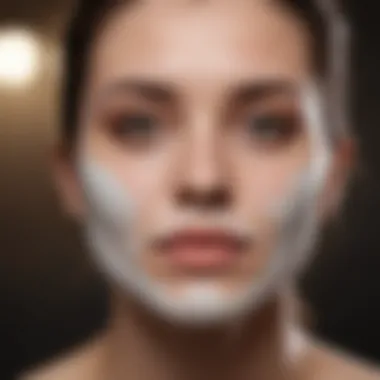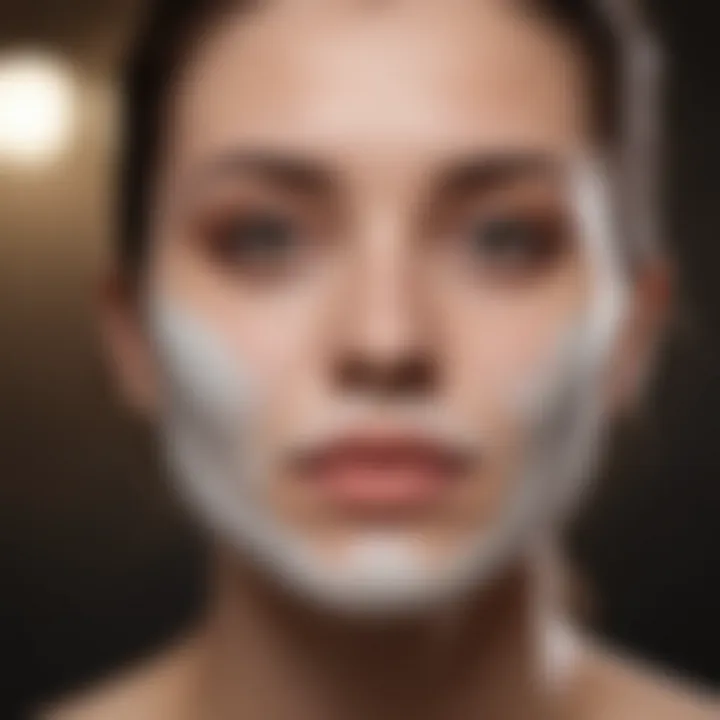Expert Strategies for Reducing Shave Bumps: A Complete Guide


Wellness
Shaving bumps can be a pesky issue for many individuals striving for smooth skin post-shave. Understanding the root causes is crucial in effectively tackling this concern. Factors such as hair texture, skin sensitivity, shaving techniques, and ingrown hairs play a role. Developing a personalized skincare routine that caters to these specific needs is paramount. Techniques like proper exfoliation, using sharp razors, and post-shave moisturization can aid in reducing shave bumps.
Lifestyle
Incorporating self-care practices into your routine can significantly impact the occurrence of shave bumps. Skincare aficionados recommend gentle cleansing, avoiding harsh chemicals, and opting for products tailored to sensitive skin. Additionally, maintaining a healthy diet and hydration levels can bolster skin resilience. Stress management techniques, such as meditation and deep breathing exercises, can also promote skin health. Moreover, establishing a consistent skincare regimen and being mindful of recurring shave bumps can aid in prevention and treatment for smoother, bump-free skin.
Tools for Living Better
Equipping yourself with the right tools for shaving is essential in mitigating shave bumps. High-quality razors, shaving creams, and aftershaves can make a notable difference in skin condition post-shave. Adopting a tried-and-tested shaving routine that includes gentle strokes, proper hydration of the skin, and adequate post-shave care can contribute to a bump-free experience. Considering factors like blade sharpness, hair growth direction, and skin type can optimize your shaving routine. Implementing these tools and techniques enhances the effectiveness of reducing shave bumps and fostering healthier skin post-shave.
Understanding Shave Bumps
In this comprehensive guide focusing on effective ways to reduce shave bumps, understanding the intricacies of shave bumps is crucial. By delving into what shave bumps are, their causes, and how to prevent and treat them, individuals can achieve smoother and healthier skin post-shaving. Understanding shave bumps allows individuals to grasp the underlying issues that lead to their formation, enabling them to tailor their shaving routines accordingly for optimal skin health.
What Are Shave Bumps?
Shave bumps, also known as razor bumps, are small, inflamed bumps that may appear on the skin after shaving. These bumps can be caused by various factors such as ingrown hairs, skin irritation, and improper shaving techniques. Understanding the nature of shave bumps is essential in adopting the right strategies to address and prevent their occurrence for improved skin texture and appearance.
Causes of Shave Bumps
Ingrown Hairs
Ingrown hairs occur when a hair curls back or grows sideways into the skin, leading to inflammation and the development of shave bumps. This common issue is often exacerbated by improper shaving techniques or tight clothing that can trap hair, highlighting the importance of proper hair removal methods to minimize ingrown hairs. Managing ingrown hairs effectively is key to reducing shave bumps and achieving smoother skin post-shaving.
Skin Irritation
Skin irritation, including redness, itchiness, and inflammation, can contribute to the formation of shave bumps. Factors such as sensitive skin, harsh shaving products, or frequent shaving can increase the likelihood of skin irritation, emphasizing the need for gentle skincare practices and suitable shaving products to prevent shave bumps. Addressing skin irritation proactively can promote healthier skin and a more comfortable shaving experience.
Improper Shaving Techniques
Improper shaving techniques, such as shaving against the grain, using dull razors, or applying excessive pressure, can result in shave bumps. These techniques can cause skin trauma and inflammation, leading to the development of razor bumps and other types of shave bumps. Adopting proper shaving methods, including gentle strokes in the direction of hair growth and regular razor replacement, is essential for preventing shave bumps and maintaining skin health.


Different Types of Shave Bumps
Razor Bumps
Razor bumps, also known as pseudofolliculitis barbae, are ingrown hairs that become trapped beneath the skin, causing inflammation and soreness. These bumps can be painful and unsightly, affecting individuals with coarse or curly hair types more frequently. Managing razor bumps involves gentle exfoliation, proper shaving techniques, and targeted skincare products to reduce inflammation and promote hair regrowth without further irritation.
Razor Burn
Razor burn refers to skin irritation and redness caused by friction during shaving, leading to a burning sensation and discomfort. This condition is often the result of using dull blades, shaving too quickly, or neglecting pre-shave preparation. To alleviate razor burn, individuals should focus on hydrating the skin, applying soothing balms, and using sharp razors to minimize friction and inflammation for a smoother shaving experience.
Pseudofolliculitis Barbae
Pseudofolliculitis barbae, commonly known as barber's itch, is a condition characterized by inflamed hair follicles caused by ingrown hairs. This condition is prevalent among individuals with curly hair who frequently shave. Preventing and treating pseudofolliculitis barbae involves adopting a gentle shaving routine, using sharp razors, and incorporating exfoliation and anti-inflammatory products into skincare regimens. By addressing the root causes of this condition, individuals can reduce shave bumps and promote healthier skin post-shaving.
Preventing Shave Bumps
In this comprehensive guide on effective ways to reduce shave bumps, the section on preventing shave bumps holds paramount importance. By focusing on proper shaving techniques, pre-shave preparation, and selecting the right products, individuals can significantly decrease the occurrence of uncomfortable shave bumps post-shaving. Understanding the causes of shave bumps and taking proactive steps to prevent them is key to achieving smoother and healthier skin.
Proper Shaving Techniques
Use a Sharp Razor
Utilizing a sharp razor is crucial in the quest to prevent shave bumps. A sharp razor ensures clean and precise cuts, reducing the likelihood of ingrown hairs and skin irritation. The key characteristic of a sharp razor lies in its ability to glide effortlessly across the skin, providing a close shave without causing unnecessary friction. While a sharp razor may require more frequent blade replacements, its efficacy in preventing shave bumps makes it a popular choice among those seeking optimal shaving results.
Shave in the Direction of Hair Growth
Adhering to the practice of shaving in the direction of hair growth can significantly minimize shave bumps. By following the hair's natural growth pattern, skin irritation and ingrown hairs are less likely to occur. The key characteristic of this technique is its ability to reduce friction on the skin, promoting a smoother shaving experience. While shaving against the grain may result in a closer shave, it also increases the risk of shave bumps due to the hair follicles' disruption.
Avoid Overly Close Shaves
Avoiding overly close shaves is essential in preventing shave bumps. Though a super-close shave may seem desirable, it often leads to skin irritation and ingrown hairs. The key characteristic of this approach is maintaining a safe distance between the razor and the skin, preventing excessive pressure and friction. While a slightly less close shave may be the sacrifice, the reduction in shave bumps makes this practice highly beneficial.
Pre-Shave Preparation
Exfoliate Before Shaving


Exfoliating the skin before shaving plays a vital role in preventing shave bumps. This process removes dead skin cells and unclogs pores, reducing the likelihood of ingrown hairs. The key characteristic of exfoliation is its ability to smoothen the skin's texture, allowing for a cleaner shave. While exfoliating may increase skin sensitivity temporarily, the long-term benefits in shave bump prevention outweigh this disadvantage.
Hydrate the Skin
Keeping the skin adequately hydrated is crucial for reducing shave bumps. Hydration maintains skin elasticity, reducing the chances of irritation and razor burns. The key characteristic of well-hydrated skin is its resilience against the razor's edge, minimizing cuts and nicks. While ensuring skin hydration may require extra steps in the shaving routine, the overall improvement in skin condition makes it a valuable choice for shave bump prevention.
Use a Pre-Shave Oil
Incorporating a pre-shave oil in the grooming routine can contribute significantly to preventing shave bumps. A pre-shave oil creates a protective barrier on the skin, reducing friction during shaving. The key characteristic of pre-shave oil is its lubricating properties, enabling the razor to glide smoothly across the skin. While adding an extra product to the routine may seem time-consuming, the non-greasy texture and added protection against shave bumps make it a worthwhile investment.
Choosing the Right Products
Selecting a Suitable Shaving Cream
Selecting a suitable shaving cream is pivotal in the journey to prevent shave bumps. A high-quality shaving cream provides lubrication and hydration to the skin, reducing friction from the razor. The key characteristic of a suitable shaving cream is its moisturizing properties, keeping the skin soft and supple post-shaving. While opting for a quality shaving cream may incur additional costs, the benefits in shave bump prevention and overall skin health make it a wise choice.
Opting for Alcohol-Free Aftershave
Opting for an alcohol-free aftershave can significantly impact shave bump prevention. Alcohol-based products tend to dry out the skin, leading to irritation and redness. The key characteristic of an alcohol-free aftershave is its soothing and moisturizing properties, promoting skin recovery post-shaving. While alcohol-free aftershave may lack the instant sting of alcohol-based alternatives, its gentle nature and nourishing effects make it an ideal choice for individuals prone to shave bumps.
Treating Shave Bumps
In the realm of grooming and skincare, treating shave bumps holds paramount importance. Shave bumps, scientifically known as pseudofolliculitis barbae, can be a persistent issue post-shaving, causing discomfort and affecting skin health. Addressing shave bumps effectively not only enhances the complexion and texture of the skin but also boosts self-confidence.
Home Remedies
Applying Aloe Vera
Delving into home remedies for combating shave bumps, one notable contender is applying aloe vera. The soothing properties of aloe vera play a pivotal role in calming irritation and reducing inflammation on the skin. Aloe vera's natural anti-inflammatory and antibacterial qualities make it an ideal choice for alleviating shave bumps and promoting skin healing. Its hydration benefits also aid in rejuvenating the skin, creating a nurturing environment for optimal recovery.
Using Tea Tree Oil
Another noteworthy home remedy in the battle against shave bumps is using tea tree oil. Renowned for its antiseptic and anti-inflammatory properties, tea tree oil helps to cleanse the skin and prevent infection. Its ability to unclog pores and reduce redness makes it a favorable choice for addressing shave bumps effectively. Incorporating tea tree oil into the skincare routine can significantly improve skin condition post-shaving.
Cold Compress


Among the arsenal of home remedies for shave bumps, the cold compress stands out for its instant relief and effectiveness. The application of a cold compress helps to constrict blood vessels, reduce swelling, and numb the affected area, providing quick comfort. The cold temperature aids in soothing the skin, minimizing discomfort, and promoting quicker recovery from shave bumps.
Medical Treatments
Topical Antibiotics
When home remedies may not suffice, turning to medical treatments like topical antibiotics becomes necessary. Topical antibiotics work by combating bacteria on the skin's surface, preventing infection and reducing inflammation. The fast-acting nature of topical antibiotics offers prompt relief from shave bumps, accelerating the healing process and restoring skin health.
Steroid Creams
For more severe cases of shave bumps, the use of steroid creams proves to be highly effective. Steroid creams help to reduce itching, inflammation, and redness associated with shave bumps, providing immediate comfort. By calming the skin and minimizing swelling, steroid creams promote healing, allowing the skin to recover and regenerate efficiently.
Laser Hair Removal
In addressing persistent shave bumps, laser hair removal emerges as a long-term solution. By targeting hair follicles and reducing regrowth, laser hair removal minimizes the likelihood of developing shave bumps. The precision of laser technology ensures minimal skin irritation and inflammation, offering a lasting remedy for those prone to recurrent shave bumps.
Lifestyle Changes for Smoother Skin
In this segment, we will delve into the crucial aspect of Lifestyle Changes for Smoother Skin, a fundamental element in our quest to combat shave bumps effectively. Making lifestyle adjustments not only enhances the skin's appearance but also contributes to overall well-being. By focusing on healthy habits, individuals can achieve a smoother complexion post-shaving, promoting skin health and radiance. Incorporating these changes can significantly reduce the occurrence of shave bumps, making skin care routines more effective and rewarding.
Healthy Skin Habits
- Maintaining Proper Hydration: Proper hydration plays a pivotal role in promoting healthy skin by keeping it supple and balanced. The key characteristic of maintaining proper hydration lies in its ability to nourish the skin from within, aiding in cell regeneration and maintaining skin elasticity. This practice ensures that the skin remains hydrated and prevents issues such as dryness and irritation, essential for reducing shave bumps.
- Balanced Diet: A well-rounded and balanced diet contributes significantly to skin health, providing essential nutrients and antioxidants that promote a clear and vibrant complexion. The key characteristic of a balanced diet is its ability to nourish the body internally, reflecting positively on the skin's outward appearance. By incorporating a variety of fruits, vegetables, and whole grains, individuals can support skin health, reducing inflammation and enhancing the skin's natural glow.
- Adequate Sleep: Adequate sleep is indispensable for skin repair and rejuvenation, playing a vital role in maintaining skin health and resilience. The key characteristic of adequate sleep lies in its ability to allow the body to undergo cellular regeneration and repair during rest, promoting overall skin rejuvenation. By ensuring sufficient sleep, individuals can boost collagen production, reduce stress-related skin issues, and improve skin texture, aiding in the reduction of shave bumps.
Regular Skin Care Routine
In this section, we will explore the importance of maintaining a regular skin care routine to complement lifestyle changes for smoother skin. A consistent routine not only addresses current skin issues but also prevents future complications, promoting long-term skin health. By incorporating cleansing, moisturizing, and sun protection into daily practices, individuals can create a robust skin care regimen that supports optimal skin condition and reduces the likelihood of shave bumps.
- Cleansing: Cleansing forms the foundation of an effective skin care routine, removing impurities, excess oil, and buildup that can clog pores and lead to skin issues. The key characteristic of cleansing is its ability to purify the skin gently, preparing it for subsequent treatments and enhancing product absorption. By choosing a suitable cleanser based on skin type, individuals can effectively prevent shave bumps and maintain a clear complexion.
- Moisturizing: Moisturizing is essential for promoting skin hydration and barrier function, preventing moisture loss and maintaining skin elasticity. The key characteristic of moisturizing lies in its ability to lock in moisture, creating a protective layer that shields the skin from external aggressors. By selecting a moisturizer tailored to specific skin requirements, individuals can replenish lost hydration, reduce skin dryness, and improve overall skin texture.
- Sun Protection: Sun protection is crucial in safeguarding the skin against UV damage, premature aging, and environmental stressors that can exacerbate skin conditions such as shave bumps. The key characteristic of sun protection is its ability to shield the skin from harmful UV rays, reducing the risk of sunburn and skin damage. By incorporating a broad-spectrum sunscreen into daily skincare, individuals can preserve skin health, prevent shave bumps, and maintain a youthful complexion.
Consulting a Dermatologist
When it comes to managing shave bumps effectively, consulting a dermatologist plays a crucial role in providing personalized care and expert advice. Dermatologists are skincare specialists trained to diagnose and treat various skin conditions, including shave bumps. Their extensive knowledge and experience enable them to offer tailored solutions based on individual skin types and concerns.
By consulting a dermatologist, individuals can receive professional guidance on addressing specific shave bump issues. Dermatologists can examine the skin, identify the underlying causes of shave bumps, and recommend appropriate treatment options. This personalized approach helps in targeting the root cause of shave bumps, leading to more effective and long-lasting results.
Moreover, dermatologists can recommend specialized skincare products that are suitable for sensitive skin and prone to shave bumps. These products may include gentle cleansers, soothing moisturizers, and targeted treatments to alleviate inflammation and promote skin healing. By following a dermatologist's recommendations, individuals can enhance their shaving routine and minimize the risk of developing shave bumps in the future.
Consulting a dermatologist also offers the benefit of accessing advanced treatments for stubborn shave bumps. In cases where home remedies and over-the-counter products have not yielded satisfactory results, dermatologists can provide medical interventions such as prescription creams, laser therapy, or other procedures to target persistent shave bumps. This comprehensive approach ensures that individuals receive comprehensive care to achieve smoother and healthier skin.
Furthermore, dermatologists can educate individuals on proper shaving techniques and skincare practices to prevent shave bumps from recurring. By understanding the importance of gentle exfoliation, proper hydration, and post-shave care, individuals can optimize their skincare routine and reduce the likelihood of developing shave bumps after shaving. Overall, consulting a dermatologist is an essential step in effectively managing shave bumps and maintaining optimal skin health.



